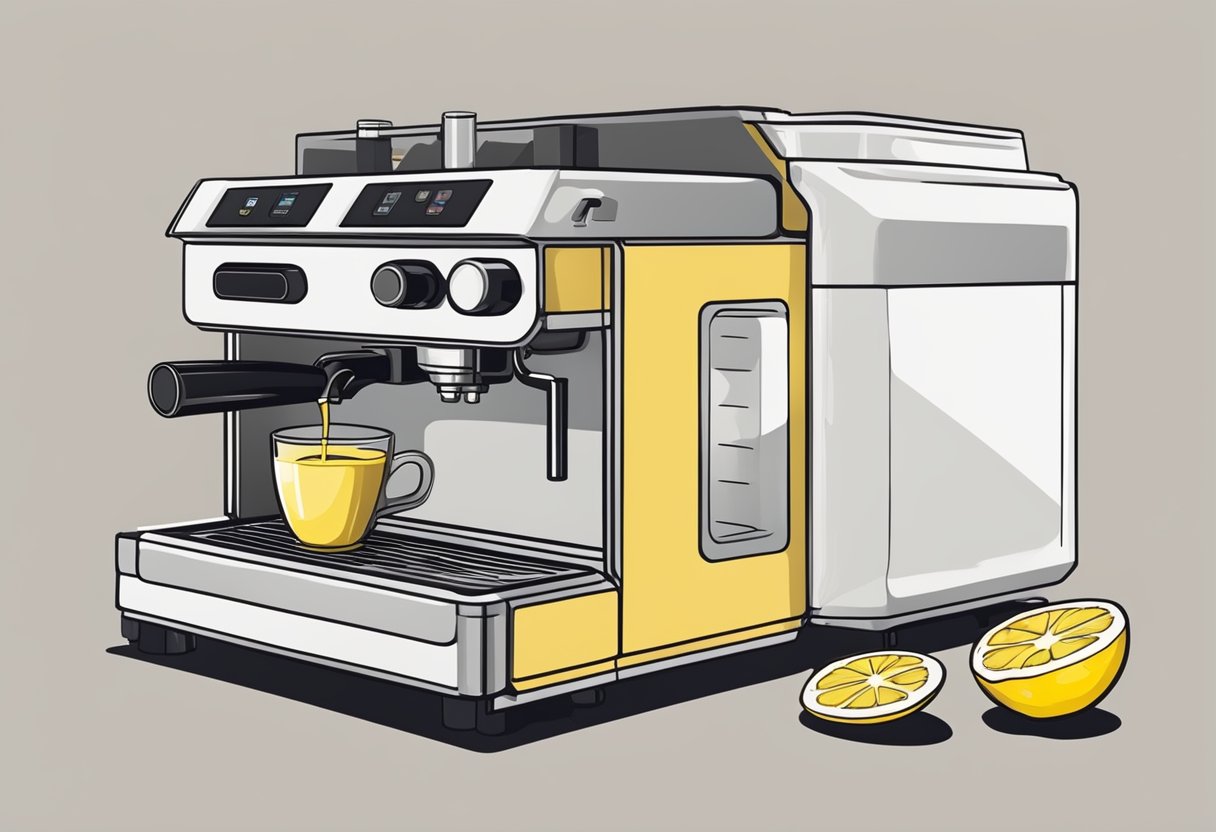Explore the invigorating realm of cleaning your coffee maker without turning to vinegar! If it’s the strong odor that’s deterring you or just an absence in your pantry, you’ll be pleased to learn there are various effective substitutes. These techniques not just restore your coffee maker to its original gleaming state but could also add a lively zest to your cleaning regimen.
How to Clean a Coffee Machine Without Vinegar: Choosing the Right Cleaning Agents

When aiming to maintain the pristine condition of your coffee machine while avoiding vinegar, it’s essential to select effective cleaning agents that are both non-toxic and health-conscious. The right alternatives can not only sanitize but also degrease, eliminating any unwelcome flavors or odors.
The Power of Citric Acid
Lemon juice is a fantastic non-toxic option for cleaning your coffee machine, thanks to its high citric acid content. Citric acid is a natural descaler that works wonders on mineral buildup. Simply mix equal parts of lemon juice and water to create your cleaning solution.
Baking Soda: The Gentle Alternative
Baking soda is not only for baking; it’s a mild, non-toxic cleaner that excels at removing stubborn coffee residue. Dissolve a quarter cup of baking soda in a cup of warm water to create a baking soda solution, and run it through your machine to gently cleanse and neutralize odors.
Exploring Other Natural Cleaners
There’s a plethora of natural cleaners at your disposal. For instance, hydrogen peroxide is effective for sanitizing, while a pinch of cream of tartar can help in descaling. If you’re dealing with hard water deposits, CLR can be a safe alternative when used properly. Just be sure to thoroughly rinse your coffee maker afterward to maintain the integrity of your coffee’s flavor.
The Role of Dish Soap and Alcohol
A few drops of dish soap in warm water can make a quick daily cleanser for your coffee machine parts, keeping residues at bay. In a pinch, alcohol, like vodka, can be used to sanitize and eradicate oily buildups, leaving no aftertaste behind when rinsed thoroughly.
Uncommon But Effective Options
Looking for something out of the box? Denture tablets can be an unexpected coffee machine cleaner, effectively tackling hard water stains. Alternatively, Alka Seltzer and a mix of salt and ice can scrub away grime without the use of harsh chemicals. These novel methods may surprise you with their cleaning efficacy.
Step-By-Step Cleaning Process

Excited to see your coffee maker shine and ensure your coffee tastes amazing every time? You’re about to learn the perfect way to clean your coffee maker without vinegar, eliminating residue and unpleasant odors with ease!
Preparation for Cleaning
Before starting, make sure your coffee maker is unplugged and cool to the touch. Empty any leftover coffee or water and remove all detachable parts, such as the carafe and the brew basket. Give them a good rinse with plain water to clear out any loose coffee grounds or oil that could interfere with the cleaning process. This is the time to whip up your cleaning solution—if you’re aiming for something as effective as vinegar but prefer a more pleasant smell, go for a mix of lemon juice and water which works wonders in neutralizing mold, bacteria, and lingering smell.
Conducting the Brew Cycle
Next up is the brewing action! Fill the water reservoir with the cleaning solution. If you opted for lemon, dilute about half a cup of lemon juice with water to the max line of the reservoir. Turn on your machine and run a brew cycle. This will pull the solution through all the nooks and crannies, tackling stains, hard water deposits, and the dreaded oil buildup. Once the cycle is done, let the solution sit for 15 minutes to ensure it does a thorough job.
- Action Step: Run at least two to three rinse cycles with plain water to wash away any remaining cleaning mix and to keep your next cup of coffee free from unexpected tastes.
Post-Cleaning Care and Tips
After the rinse cycles, it’s time to wipe down the exterior and clean any remaining parts such as the filter basket. A soft cloth can help you reach into the water reservoir and remove any leftover residue. Always dry all components thoroughly before reassembling your coffee maker. Regular maintenance like this not only leaves your machine sparkling clean but also enhances the overall taste and longevity of your device, without the drawbacks of using vinegar.
- Important Tip: If you live in an area with hard water, consider using bottled or filtered water moving forward to prevent scale buildup, keeping your coffee machine in top condition for longer.
Frequently Asked Questions

Explore these quick and natural solutions to keep your coffee maker in top shape without reaching for the vinegar.
What’s a quick and easy way to clean my coffee maker using dish soap?
You’ll love this simple method: just fill the carafe with warm water, add a few drops of dish soap, and run it through a brewing cycle. Remember to rinse thoroughly!
Can lemon juice be an effective substitute for vinegar in cleaning coffee machines?
Absolutely! Lemon juice’s natural acidity makes it a fantastic cleaning agent for coffee machines. It’s as easy as mixing equal parts of lemon juice and water and running it through a cycle.
What are the top home remedies for a fresh and clean coffee maker?
Top home remedies include using baking soda, lemon juice, or hydrogen peroxide to clean your coffee maker. These are all natural and readily available.
Is it safe to clean my coffee maker with hydrogen peroxide, and if so, how?
Yes, it’s safe! Mix a 50/50 solution of hydrogen peroxide and water, run it through your coffee maker, then follow up with a couple of cycles of plain water before brewing coffee.
What unique cleaning solutions can I use for my Keurig coffee machine?
For your Keurig, try running a cycle with a mix of water and cream of tartar—it’s a less-known but effective cleaning solution. Or opt for Keurig’s own descaling solution specifically designed for their machines.
What steps should I follow to effectively clean my coffee maker using baking soda?
Create a cleaning powerhouse with baking soda: just one quarter of a cup dissolved in water. Run it through your machine, then rinse with several cycles of water to get rid of any residue.


